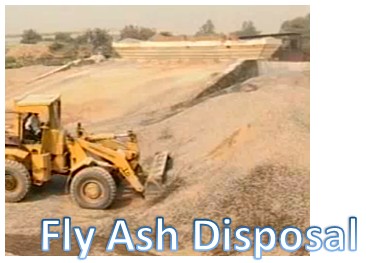Fly Ash Disposal
Fly ash is typically collected in the flue of the combustion unit and transported to centralized entertainment area for treatment and storage.
Its disposal requires large quantities of land, water and energy. But also by virtue of their weightlessness, can become air borne. Huge quantity of ash dose poses challenging problems, in the form of land usage, health hazards and environmental dangers.

Fly ash an oxide rich waste product of thermal power plant can be used as the raw material for different industries.
They are as follows:
a. In the manufacture of city fly ash tricks.
b. Hollow blocks in the construction of buildings.
c. In the manufacturing of asbestos sheets.
d. For road embankment.
e. For construction of railway embankments and filling.
f. Used as raw material for the detergent industry.
Other Uses of fly ash are as follows:
It can be used for filling of land, soil stabilization, light weight building material, roofing materials, roofing granules, plastics, paint, filter doth pre coat for sludge, watering, pipe bedding, structural fills, concrete and block Portland cement, mine reclamation, agricultural enhancement, flood paving: as a sub-base or fill material under a paved road.
Recycling and Reuse of Fireside Wastes of Site
Coal ash is used as a substitute for cement in concrete or as structural fill. With the exception of cooling water and used oil, fly ash represents the greatest waste component etc. fossil fuel plants. For this reason Recycling options for fly ash present a significant opportunity for production prevention. The conditions and transportation costs of fly ash should be simple and cheap. In addition, the ash must have low carbon content. The available commercial technologies can separate the ash into carbon-rich and carbon-poor fractions.
Boiler Chemical Cleaning
The purpose of boiler chemical cleaning is to remove scale from the boiler tubes. The waste generated contains spent cleaning solution and the scaling components, such as copper, iron, zinc, nickel, magnesium and chromium.
Boiler cleaning wastewater may be difficult to treat it is hazardous waste.
The basic method to control boiler feed water is to control the rate of scaling. Generally boiler water is treated through the fine filtration chemical treatment, reverse osmosis and ion exchange to remove minerals. Other constituents in the boiler targeted for removal may include oxygen and carbon dioxide.
On line cleaning involves the boiler cleaning when the boiler is under operation. This clearing uses less hazardous chemicals and results in a more easily handled waste.
Average Acceleration Calculator
Average acceleration is the object's change in speed for a specific given time period. ...
When an object falls into the ground due to planet's own gravitational force is known a...
In Mathematics, the permutation can be explained as the arrangement of objects in a particular order. It is an ordered...
A rectangle can be explained as a 4-sided quadrilateral which contains equal opposite sides. In a rectangle
A three sided polygon which has three vertices and three angles is called a triangle. Equilateral triangle...







